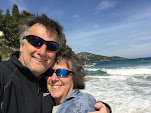 |
| On Point Car with Orange Bulkheads |
Left is Paul Ciccarello's car featuring strenghtened 7075 alloy rear pob bulkheads in orange.
The standard kit S120 bulkheads are a work of art but are not made from the strongest alloy from what I can tell. The motor side plate is prone to bending. I have had some success in bending them back but it is tricky to get right.
 |
| Comparing Standard (silver) and On Point (black) parts |
The pic left shows that the On Point parts have thicker webs, especially around the motor mount holes. They are also made from the best 7075 T6 alloy.
 |
| My car with On Point pods fitted. |
Paul can be contacted at info@onpointracing.com
European distribution of Paul's On Point products is via Markus Mobers at http://www.speedtechrc.de/ Markus is at markus962@hotmail.com































